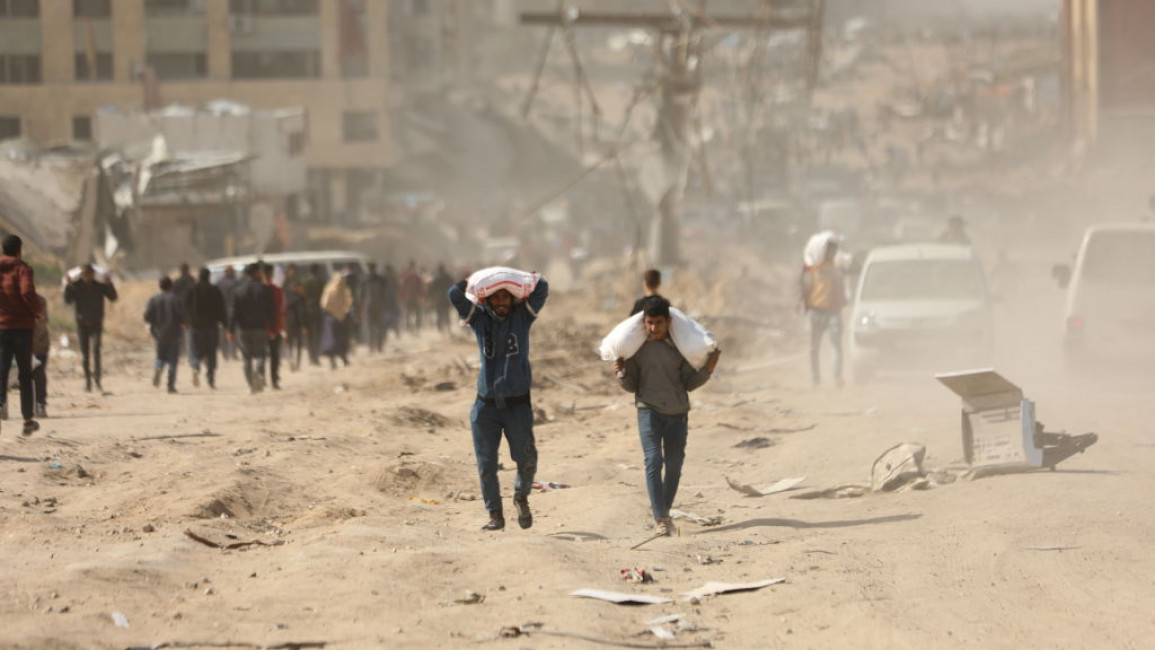How Israel has disrupted north Gaza's aid distribution
Israeli forces have attacked numerous aid convoys attempting to enter northern Gaza, killing dozens of people, mostly occurring at the Nabulsi roundabout on Al-Rashid Street and the Kuwaiti roundabout on the Salah al-Din street that run through Gaza.
We look at the major incidents that have taken place on this route and the impact on aid reaching northern Gaza.
The Flour Massacre
These attacks include the now-infamous 'Flour Massacre' when on the morning of 29 February, Israeli forces fired live rounds at thousands of starving Palestinians flocking to a 30-truck aid convoy.
The incident resulted in at least 112 Palestinians killed and 760 wounded, drawing international condemnation from figures including the UN's Antonio Guterres and French President Emmanuel Macron.
Israel has denied responsibility for the incident, although reports from Euro-Med Human Rights Monitor reveal that most of those killed and wounded were shot.
On Wednesday, the group released a new report revealing that a sample of 200 victims had wounds from 5.56x45mm NATO caliber rounds, which are used by the Israeli army
Other attacks against Palestinians waiting for aid
In addition to the flour massacre, several other attacks have been carried out by the Israeli army against Palestinians waiting for aid convoys.
On Wednesday, Al Jazeera reported that at least eight people were wounded after Israeli forces fired on individuals awaiting a humanitarian aid convoy at the Nabulsi roundabout.
As well as the attacks on the Nabulsi roundabout, the Israeli army has attacked Palestinians numerous times at the Kuwaiti roundabout on Salah al-Din street, the second major road that runs up the Gaza Strip.
On 25 January at least 20 people were killed and 150 wounded when the Israeli army attacked people waiting for food aid at the Kuwaiti roundabout according to Gaza's health ministry.
Further attacks by Israeli forces on the road were also reported on Monday and Tuesday, although it's unknown how many people were killed or wounded in the incidents.
Why the Nabulsi and Kuwaiti roundabouts?
The Nabulsi roundabout is a junction in the north of the enclave running along Gaza's costal Al-Rashid Road. Since the war began the road has become the main route for aid trucks heading into northern Gaza.
Similarly, the Kuwaiti roundabout is a junction on the parallel Salah al-Din road, which also runs the length of the Gaza Strip.
The junctions are also near Israeli checkpoints which have been set up along the roads in the newly created Israeli controlled Netzarim corridor that splits the enclave in two.
These checkpoints regulate both the southward exit of Palestinians from northern Gaza, which has involved the detention of Palestinians, and the entry of aid into the strip.
As the first points of entry for aid entering northern Gaza, these roundabouts are also the first point at which Palestinians can receive aid, with many instances of groups of people looting aid in an increasing sign of desperation as starvation becomes rife in the north of the enclave.
These points of entry have also been witness to Israel's blockade of aid entering Gaza. This includes the Wadi Gaza checkpoint which has been used to check most humanitarian aid flowing into northern Gaza.
According to a report from Refugees International, since 1 January less than 20 percent of all humanitarian aid convoys destined for northern Gaza have been granted entry.
Both entry and denial of convoys occur after hours long delays, with each denial being given after initial Israeli approval for the convoy to head towards and enter into the north.
Attacks by Israeli forces on Palestinians waiting for food convoys, combined with the heavy restrictions on the entry onto aid convoys have resulted in a dire humanitarian situation in the north.
Refugees International reports that an estimated 90 percent of young children and breastfeeding women are facing severe food poverty, with approximately 90 percent of children under five suffering from at least one infectious disease.
According to Gaza's ministry of health, 20 people in northern Gaza have died from malnutrition, including both children and the elderly.



